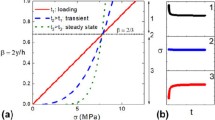Abstract
Variation of stress across the length and thickness of a cantilever during creep allows obtaining multiple pairs of strain rates and stress under steady-state condition. This work applies digital image correlation (DIC) and conjugate analytical models to obtain several such “strain rate–stress” pairs during steady-state creep by testing a single cantilever at a constant applied load. Furthermore, these strain rate–stress pairs are used to accurately determine the stress exponent of the material (e.g., Al and Pb). In addition, an empirical observation of plotting strain rate as a function of stress at fixed strain during primary creep for estimating stress exponent is extended to bending creep, wherein strain rates of the points in the cantilever lying on an iso-strain contour were plotted against the moment at the point to determine stress exponent. This study, thereby, proves that the “bending creep–DIC” combination is a high throughput test methodology for studying steady-state creep.






Similar content being viewed by others
References
J-P. Poirier: Creep of Crystals (Cambridge University Press, Cambridge, U.K., 1985).
ASTM E139-11(2018), Standard Test Methods for Conducting Creep, Creep-Rupture, and Stress-Rupture Tests of Metallic Materials (2018).
S.I.A. Jalali, P. Kumar, and V. Jayaram: Creep of metallic materials in bending. JOM 71, 3563 (2019).
H.J. Tapsell and A.E. Johnson: An investigation of the nature of creep under stresses produced by pure flexure. Mon. J. Inst. Met. 58, 387 (1935).
E.P. Popov: Bending of beams with creep. J. Appl. Phys. 20, 251 (1949).
G.W. Hollenberg, G.R. Terwilliger, and R.S. Gordon: Calculation of stresses and strains in four-point bending creep tests. J. Am. Ceram. Soc. 54, 196 (1971).
F.K. Zhuang, S.T. Tu, G.Y. Zhou, and Q.Q. Wang: A small cantilever beam test for determination of creep properties of materials. Fatigue Fract. Eng. Mater. Struct. 38, 257 (2015).
G.T. Harris and H.C. Child: Creep testing by a cantilever-bending method. J. Iron Steel Inst. 165, 139 (1950).
A.R.A.F. Ragab and S.E.A. Bayoumi: Engineering Solid Mechanics: Fundamentals and Applications (CRC Press, Washington, D.C., 2018).
J. Weertman: Creep of indium, lead, and some of their alloys with various metals. Trans. Metall. Soc. 218, 207 (1960).
S.I.A. Jalali, P. Kumar, and V. Jayaram: “ High Throughput Determination of Creep Parameters Using Cantilever Bending: Part II - Primary and Steady-State through Uniaxial Equivalency ”. J. Mater. Res. (2020).
S. Straub and W. Blum: Does the “natural” third power, law of steady state creep hold for pure aluminum? Scr. Mater. 24, 1837 (1990).
J. Weertman: Creep of aluminum single crystals. J. Appl. Phys. 27, 832 (1956).
M.E. Kassner, P. Kumar, and W. Blum: Harper-Dorn creep. Int. J. Plast. 23, 980 (2007).
D.A. Woodford: Measurement and interpretation of the stress dependence of creep at low stresses. Mater. Sci. Eng. 4, 146 (1969).
S.I.A. Jalali, P. Kumar, and V. Jayaram: A System and Method for Determination of Power Law Creep Parameters from a Single Bending Test Indian Patent Application No. 201941028031, 2019.
M.A. Sutton, J. Orteu, and H.W. Schreier: Image Correlation for Shape, Motion and Deformation Measurements (Springer, New York, 2009).
M.E. Kassner: Fundamentals of Creep in Metals and Alloys (Butterworth-Heinemann, Elsevier, Boston, Massachusetts, 2015).
Acknowledgments
The authors would like to thank the Aeronautical Research and Development Board, India (ARDB 0242), and Ministries of Human Resource Development and Power, Government of India (IMPRINT 0009), for financially supporting this work.
Author information
Authors and Affiliations
Corresponding authors
Supplementary material
Rights and permissions
About this article
Cite this article
Jalali, S.I.A., Kumar, P. & Jayaram, V. High Throughput Determination of Creep Parameters Using Cantilever Bending: Part I - Steady-State. Journal of Materials Research 35, 353–361 (2020). https://doi.org/10.1557/jmr.2020.36
Received:
Accepted:
Published:
Issue Date:
DOI: https://doi.org/10.1557/jmr.2020.36




